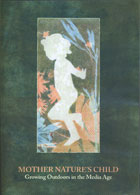
Mother Nature’s Child: Growing Outdoors in the Media Age 2010
Distributed by Fuzzy Slippers Productions, PO Box 184, Burlington, VT 05402-0184
Produced by Camilla Rockwell & Wendy Conquest
Directed by Camilla Rockwell
DVD, color, 54 min.
Jr. High - General Adult
Child Development, Children, Education, Adolescence
Date Entered: 07/08/2011
Reviewed by Winifred Fordham Metz, University of North Carolina at Chapel HillDirector/Producer Camilla Rockwell has a rich history in documentary filmmaking, spending several years working with Ken Burns at Florentine films. Mother Nature’s Child is her third independent film and seems to be a deeply personal project in many regards. Certainly influenced by author Richard Louv’s book Last Child in the Woods, Rockwell’s film sets out to convey the importance of free play outdoors, in the ever growing digital age. Rockwell is concerned that our society –particularly our children – is experiencing a deficiency of nature. The film opens with archival footage of children enraptured in creative and exploratory play outdoors while audio plays in the background with adult voices recalling memories of daylong junkets spent in backyards and woods, making mudpies and building forts. These bucolic recollections are juxtaposed with current footage of adolescents sitting indoors singularly engrossed in their virtual play via all manner of monitor or digital device.
The film is arranged into nine sections – beginning with “Early Childhood: Learning Through Senses” to “Adolescence: Risk & Community” and its conclusion of “Happier, Healthier, Smarter.” Sections like “State of Fear,” “Seeds of Stewardship,” and “Deep Questions” intend to propel the film forward. Throughout, Rockwell consults principles in the field like Audubon medal recipient and aforementioned author Richard Louv, Stephen Kellert from Yale University’s School of Forestry & Environmental Studies as well as esteemed educators Brother Yusuf Burgess & Amy Beam, and naturalists Misha Golfman, Jon Young and Andy Gonzales (one of the founders of the Holistic Life Foundation).
Rockwell crafts her thesis with selected sound bites. Louv asserts that our society is “…basically raising [children] under house arrest …” and that there are psychological, physical and spiritual implications to that. Kellert laments that “children today spend on average, over 44 hours a week in front of a monitor … and less than 40 minutes outside.”
Talking-heads commentary is fairly well balanced and ultimately underscored with examples of children experiencing nature. The camera follows students from one of Beam’s Beyond the Walls classes in Washington, DC, as they leave the storefront school, crossing urban terrain to alight in the woods of a nearby park. Inner-city teens in NY are shown working with Burgess and a fishing expert to learn to cast and bait hooks. Vermont pre-teen Rachel Witowski goes hunting with her grandfather. And the film wraps up with an extended visit to Kroka Expeditions in New Hampshire as a group of teenagers finishes its six-month nature expedition.
The pacing of the film certainly reflects the subject matter, slow and plodding at times with a somewhat forced ruminative quality (may be a bit off putting for some until resigning themselves to the pace). Some of the folks interviewed in the film go un-credited (like Andy Gonzales of the Holistic Life Foundation and co-founders Ali and Atman Smith). And, sections of the film seem to be a bit unfocused with some more developed than others. Overall, the film achieves much of what it intended – articulating the decline of our society’s experiential connection with nature; outlining some of the adverse effects (childhood obesity, depression, attention disorders); and exemplifying proactive and alternative approaches to addressing these concerns through programs like those started by Beam, Burgess, and Gonzales.
This film will be of interest to folks looking to engender and/or continue conversations on the importance of nature to our society and children’s development. Film may be used in selected classrooms or educator training to motivate discussions on these and related topics.